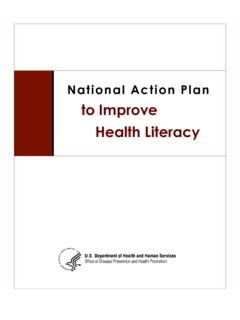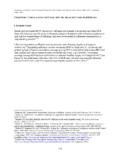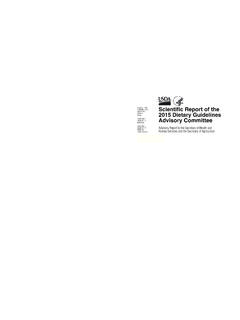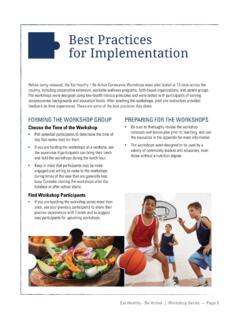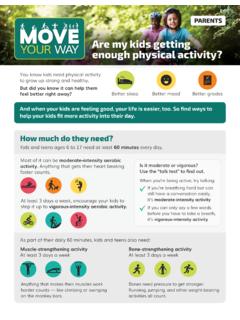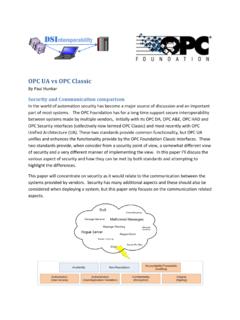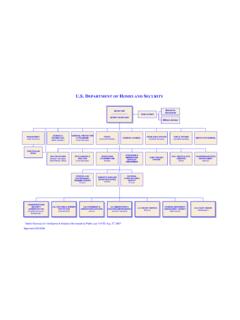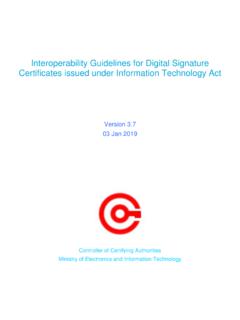Transcription of National Action Plan for Adverse Drug Event Prevention
1 National Action Plan for Adverse Drug Event Prevention Suggested citation: Department of Health and Human Services, Office of Disease Prevention and Health Promotion. (2014). National Action Plan for Adverse Drug Event Prevention . Washington, DC: Author. N a t i o n a l A c t i o n P l a n f o r A d v e r s e D r u g E v e n t P r e v e n t i o n| iii Foreword I am pleased to share the National Action Plan for Adverse Drug Event Prevention (ADE Action Plan). As we know, millions of Americans take medications every day to prevent and treat a variety of health conditions, and advances in therapeutics have improved and saved millions of lives. However, medications can also cause harms known as Adverse drug events (ADEs) that are often preventable. ADE Prevention is an important patient safety priority, with ADEs accounting for an estimated one-third of hospital Adverse events and approximately 280,000 hospital admissions annually.
2 The Department of Health and Human Services (HHS) encourages the Prevention of Adverse drug events through coordination and partnerships with public and private sector stakeholders. The ADE Action Plan identifies efforts to date to measure and prevent ADEs, and promote medication safety. In addition, this plan outlines future opportunities to advance patient safety with regard to the Prevention of Adverse drug events among three primary drug classes: anticoagulants, diabetes agents, and opioids. The ADE Action Plan is intended to encourage nationwide efforts to coordinate Federal resources and activities that will reduce preventable Adverse drug events and increase awareness of the importance of medication safety. Achieving high-quality health care for all Americans is a top priority for the Government. By improving patient safety, we can lower health care costs for the Nation and improve the care that we provide to patients, their families, and the community at large.
3 Through ongoing collaboration, we can realize our vision of a healthy and productive society. Patients across the nation depend on our efforts to ensure that the health care they receive is effective and efficient, and guarantees the highest quality of care. The ADE Action Plan helps achieve the Nation s goal to strengthen health systems by improving the quality of health care and ensuring patient safety. Through ongoing efforts and the investment of resources to prevent unnecessary medication errors and resulting complications, America can become a stronger and healthier Nation. The National Action Plan for Adverse Drug Event Prevention is a major step toward realizing this vision. Sincerely, Howard Koh, , Assistant Secretary for Health Department of Health & Human Services N a t i o n a l A c t i o n P l a n f o r A d v e r s e D r u g E v e n t P r e v e n t i o n | iv Contents Foreword .. iii List of Acronyms viii Executive Summary 1 Introduction 4 Adverse Drug Events: Magnitude of the Problem 5 Federal Interagency Steering Committee and Workgroups for ADEs 10 References 13 Section 1.
4 National ADE Action Plan Scope and Development16 Scope of the National Action Plan for ADE Prevention 16 Framework for the National Action Plan for ADE Prevention 17 Development Process for the National Action Plan for ADE Prevention 18 References 21 Section 2. Surveillance Resources 23 Considerations for Choosing Surveillance Data Sources and Metrics 23 Federal Systems That Conduct ADE Surveillance 26 Future Considerations for Optimizing Federal ADE Surveillance Efforts 30 References 31 Section 3. Prevention Approaches 33 Key Determinants of Preventable ADEs 33 Affordable Care Act Health Care Delivery Models 35 References 36 Section 4. Incentives and Oversight Opportunities 37 Regulatory Oversight 37 Value-Based Purchasing Financial Incentives 39 Transparency and Associated Incentives 45 Related Initiatives Addressing ADEs 45 Section 5. Anticoagulants 50 Magnitude of the Problem 50 Surveillance 55 Evidence-Based Prevention Tools 58 Incentives and Oversight 74 C o n t e n t s N a t i o n a l A c t i o n P l a n f o r A d v e r s e D r u g E v e n t P r e v e n t i o n | v.
5 Health Information Technology (Health IT) 80 Research (Unanswered Questions) 84 References 88 Section 6. Diabetes Agents 99 Magnitude of the Problem 99 Surveillance 102 Evidence-Based Prevention Tools 105 Incentives and Oversight 116 Health Information Technology (Health IT) 119 Research (Unanswered Questions) 122 References 124 Section 7. Opioids 131 Magnitude of the Problem 131 Surveillance 134 Evidence-Based Prevention Tools 138 Incentives and Oversight 148 Health Information Technology (Health IT) 150 Research (Unanswered Questions) 152 References 154 Conclusions and Next Steps 157 Appendix A. Key Partnerships in Development of the National ADE Action Plan 160 Appendix B. Overview of Federal Systems That Conduct ADE Surveillance 162 Appendix C. Affordable Care Act Health Care Delivery Models Relevant to ADE Prevention 168 Appendix D. Overview of CMS Programs/Initiatives With Potential To Advance ADE Prevention 170 Figures Figure 1. Terms Relevant to Drug-Related Harm 5 Figure 2.
6 Hospital Stays Complicated by Adverse Drug Events, Distribution by Age 8 Figure 3. Rate of Ambulatory Visits for Adverse Drug Events, Distribution by Age 8 Figure 4. Organizational Structure of the Federal Interagency Steering Committee and Workgroups for Adverse Drug Events 12 Figure 5. Strengths and Limitations of Federal Systems That Conduct ADE Surveillance 29 Figure 6. Fishbone Diagram: Select Determinants of Preventable Adverse Drug Events 34 .. C o n t e n t s N a t i o n a l A c t i o n P l a n f o r A d v e r s e D r u g E v e n t P r e v e n t i o n | vi .. Figure 7. Federal Interagency Workgroup Recommendations for Actions That Can Potentially Advance Surveillance Strategies for Anticoagulant ADEs 57 Figure 8. Federal Assets Related to Safe Management of Anticoagulation Therapy, as Identified by the National Quality Strategy Priorities 59 Figure 9. Opportunities for Advancing Anticoagulant ADE Prevention Strategies/Tools, as Identified by the National Quality Strategy Priorities Inpatient Settings 62 Figure 10.
7 Opportunities for Advancing Anticoagulant ADE Prevention Strategies/Tools, as Identified by the National Quality Strategy Priorities Outpatient Settings 70 Figure 11. Federal Interagency Workgroup Recommendations for Actions That Can Potentially Advance Health Care Policy Strategies for Anticoagulant ADE Prevention 77 Figure 12. Federal Interagency Workgroup Recommendations for Actions That Can Potentially Advance Research Strategies for Anticoagulant ADE Prevention 87 Figure 13. Actions That Can Potentially Advance Surveillance Strategies for Diabetes Agent ADEs105 Figure 14. Federal Assets Related to Management of Diabetes Agents, as Identified by the National Quality Strategy Priorities 106 Figure 15. Opportunities for Advancing Diabetes Agent ADE Prevention Strategies/Tools, as Identified by the National Quality Strategy Priorities Inpatient Settings 110 Figure 16. Opportunities for Advancing Diabetes Agent ADE Prevention Strategies/Tools as Identified by the National Quality Strategy Priorities Outpatient Settings 114 Figure 17.
8 Federal Interagency Workgroup Recommendations for Actions That Can Potentially Advance Health Care Policy Strategies for Diabetes Agent ADE Prevention 117 Figure 18. Federal Interagency Workgroup Recommendations for Actions That Can Potentially Advance Research Strategies for Diabetes Agent ADE Prevention 123 Figure 19. Federal Interagency Workgroup Recommendations for Actions That Can Potentially Advance Surveillance Strategies for Opioid ADEs 138 Figure 20. Federal Assets Related to Safe Management of Opioid Therapy, as Identified by the National Quality Strategy Priorities 140 Figure 21. Opportunities for Advancing Opioid ADE Prevention Strategies/Tools, as Identified by the National Quality Strategy Priorities Inpatient Settings 142 Figure 22. Opportunities for Advancing Opioid ADE Prevention Strategies/Tools, as Identified by the National Quality Strategy Priorities Outpatient Settings 143 Figure 23. Federal Interagency Workgroup Recommendations for Actions That Can Potentially Advance Health Care Policy Strategies for Opioid ADE Prevention 150 Figure 24.
9 Federal Interagency Workgroup Recommendations for Actions That Can Potentially Advance Research Strategies for Opioid ADE Prevention 153 C o n t e n t s N a t i o n a l A c t i o n P l a n f o r A d v e r s e D r u g E v e n t P r e v e n t i o n| v i i Tables ..Table 1. Examples of How Health Information Technology Can Support Goals of the ADE Action Plan 19 Table 2. 2014 EHR Incentive Program Core and Clinical Quality Measures Related to Medication Safety 20 Table 3. Summary of Metrics Related to Anticoagulant ADEs Collected by Federal Surveillance Systems 56 Table 4. Department of Veterans Affairs National Center for Patient Safety Actions From VA and Non-VA Facilities To Control Vulnerability From Anticoagulation 65 Table 5. National Quality Forum (NQF)-Endorsed Health Care Quality Measures Specific to Anticoagulation Safety 78 Table 6. Measure Considerations for EHR (Stage 3) Meaningful Use Requirements That Can Potentially Advance Anticoagulant ADE Prevention , as Proposed by the Federal Interagency Workgroup for ADEs 82 Table 7.
10 Possible Areas for Health Care Quality Measure Concept Development Related to Anticoagulant ADE Prevention and Current Barriers to Development84 Table 8. Summary of Metrics Related to Diabetes Agent ADEs (Hypoglycemia), Collected by Federal Surveillance Systems 102 Table 9. National Quality Forum (NQF) Endorsed Health Care Quality Measures Specific to Diabetes Medication Management and Hospital Admissions* 118 Table 10. Measure Considerations for EHR (Stage 3) Meaningful Use Requirements That Can Potentially Advance Diabetes Agent ADE Prevention , as Proposed by the Federal Interagency Workgroup for ADEs 119 Table 11. Summary of Opioid ADE Metrics Collected by Federal and Relevant State Surveillance Systems 135 Table 12. Summary of Metrics Related to Opioid ADEs Collected by Federal and Relevant State Surveillance Systems 136 Table 13. Systematic Actions From VA and DOD Facilities for Safe and Effective Opioid Use for Pain Management 147 Table 14. Measure Considerations for EHR (Stage 3) MU Requirements That Can Potentially Advance Opioid ADE Prevention , as Proposed by the Federal Interagency Workgroup for Opioid ADEs 152.

